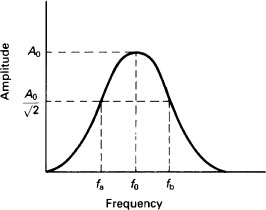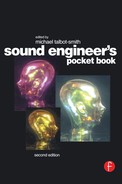Piezoelectric Transducers
Natural materials: quartz, SiO2.
Synthetic materials include certain plastics and ceramics containing lead zirconate and titanate (PZT). The latter have to be electrically polarized by placing them in a strong electric field. For this reason they are known as ‘ferroelectrics’ by analogy with the magnetization of a ferromagnet. Four constants characterize the performance and efficiency of piezoelectric transducers:
1. Bandwidth, Q
![]()
where ffun = the fundamental resonant frequency, and fa and fb are the frequencies at which the transducer output amplitude falls to ![]() of the amplitude at ffun.
of the amplitude at ffun.

Figure 144 Graph of amplitude versus frequency, yielding the Q factor
2. Electromechanical Coupling Coefficient, k
k = √(fraction of mechanical energy that goes to produce an electric field in the piezo)
or
k = √(fraction of electrical energy that goes to produce mechanical energy)
3. ![]()
(The electric field is in V/m, the stress is in Pa.)
4. ![]()
(Charge is in C, force is in N.)
or
![]()
(Units are m and V, respectively.)
In general:
Good receiver: |
low d, |
high g |
Good transmitter: |
high d, |
low g |
Electromagnetic Acoustic Transducers (EMAT)
Detection using an EMAT is illustrated in Figure 145 and Figure 146.

Figure 145 In-plane motion detection. Bs is the static magnetic field due to the magnet, Be is the varying magnetic field caused by the eddy current

Figure 146 Out-of-plane motion detection with an EMAT
Magnetostrictive Transducers
A change in the dimensions of the material results from the application of a magnetic field. The amount of change depends on the material and its internal structure. Some materials such as Turfinol (Fe, Tb and Py) can expand by up to 1 per cent.
Ferromagnetic materials can be ultrasonically tested for defects by making use of their own magnetostrictive properties, as shown in Figure 147.
Reasons for the Use of Ultrasonics in Industry
1. Non-destructive – the sample is not affected and there may not even need to be contact between the sample and the ultrasound generator and detector.
2. Environmentally safe and clean.
3. Easy to use. Operators of ultrasound equipment need little training and many processes can be automated.
4. Accurate. Surface displacements of as little as 0.02 nm can be detected using laser interferometry. Thickness measurements down to 10 μm are possible.

